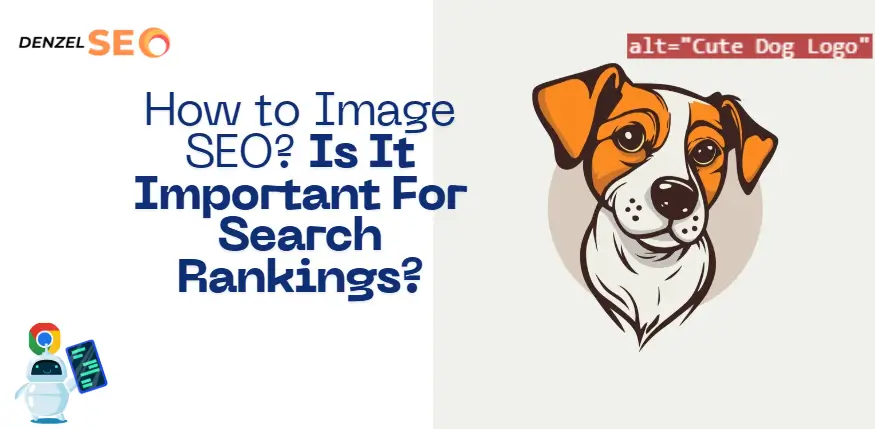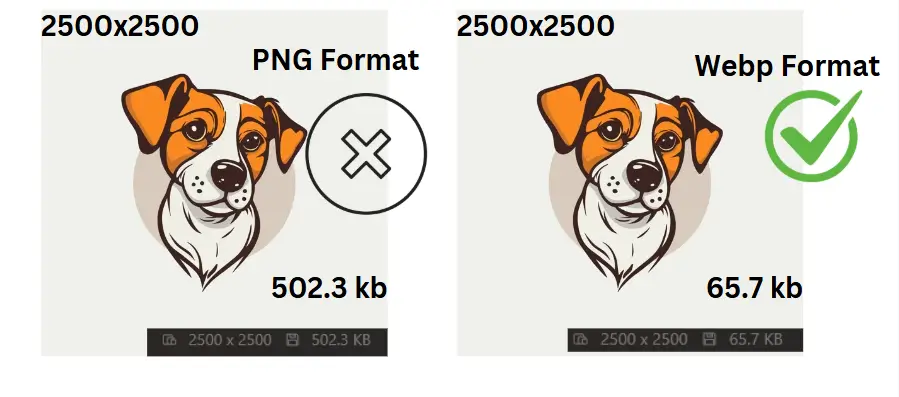Image SEO Guide: How to Optimize Images for Higher Google Rankings
- March 17, 2025
- Denzel D. Salazar
- 1:58 pm

What is Image SEO?
Image SEO refers to the process of making images more search-engine friendly by optimizing various elements such as file size, format, alt text, and structured data. It ensures that images load quickly, are accessible to all users, and contribute to overall site performance.
- Image SEO (Search Engine Optimization) is the process of optimizing images to improve search rankings and enhance user experience.
- This includes reducing file sizes, adding descriptive alt text, using structured data, and ensuring images are mobile-friendly.
Why is Image SEO Important?
Well-optimized images help websites in multiple ways. They enhance page load speed, which is a key ranking factor, improve accessibility for visually impaired users, and increase the chances of appearing in Google Image Search. Additionally, optimized images provide a better user experience by ensuring faster and smoother browsing. For Google’s official recommendations on image optimization, check out Google’s Image SEO Guidelines.
- Better Search Rankings – Well-optimized images can appear in search results, increasing traffic.
- Faster Page Load Speed – Optimized images improve Core Web Vitals, boosting overall SEO.
- Enhanced Accessibility – Proper alt text helps visually impaired users navigate content.
- Higher Engagement – Faster-loading, well-tagged images improve user experience and retention.
How to Choose the Right Image Format for SEO
Selecting the correct image format is crucial for balancing quality and performance. Different formats like JPEG, PNG, WebP, and AVIF offer varying levels of compression and quality retention. Using the right format ensures that images look good while keeping file sizes small for faster loading.
Best Image File Types for SEO Optimization
- JPEG – Ideal for general web use and photos; small file size with good quality.
- PNG – Best for graphics and transparent backgrounds; high quality but larger file size.
- WebP – Modern format offering better compression while retaining quality.
- SVG – Best for logos and icons; scalable without losing quality.
- AVIF – High-quality modern format with excellent compression but limited browser support.
SEO Tip: Use WebP or AVIF for smaller file sizes and faster loading times.
Image Compression and Optimization Techniques

Reducing image file sizes without sacrificing quality is essential for maintaining fast-loading pages. Compression tools and techniques help minimize file sizes, ensuring that web pages remain lightweight and responsive. This is particularly important for mobile users, where slow loading times can increase bounce rates.
Why Compress Images for Faster Load Speed & SEO
- Large images slow down websites, negatively impacting SEO and user experience.
- Compression reduces file size without noticeable quality loss.
Top 5 Best Image Compression Tools for SEO
- TinyPNG
- Squoosh
- ImageOptim
- ShortPixel
- Cloudflare Polish
SEO Tip: Keep images under 150KB whenever possible for faster loading times.
Using Alt Text, Titles, and Captions Effectively

Alt text and captions help search engines understand the content of images while also improving accessibility for visually impaired users. Writing clear and descriptive alt text ensures that images contribute to search rankings and provide context when images fail to load.
Google uses filenames to understand image content. However, filenames alone aren’t enough—proper on-page optimization ensures search engines index your content correctly. Learn more about SEO-friendly page structure to improve rankings
What is Alt Text?
- Alt text describes an image for search engines and visually impaired users.
- It improves accessibility and helps images rank in Google Images.
Best Practices for Alt Text
- Be descriptive: “Golden retriever puppy playing in a park with a blue ball.”
- Use keywords naturally: “Best chocolate cake recipe with dark chocolate ganache.”
- Keep it short (max 125 characters).
- Avoid keyword stuffing.
SEO Tip: If an image is decorative, use empty alt text (alt=””) to help screen readers ignore it.
Image Filename and URL Structure for SEO
Search engines use filenames and URLs to determine the relevance of an image. Properly naming images with descriptive keywords and structuring URLs in an SEO-friendly way can improve image discoverability and indexing.
Why Do Image Filenames Matter?
- Google uses filenames to understand image content. A properly named file improves SEO.
Best Practices for Image Filenames
- Use descriptive names: “red-running-shoes-nike.jpg”
- Use hyphens instead of underscores: “blue-mountain-landscape.jpg”, not “blue_mountain_landscape.jpg”
- Include relevant keywords naturally.
SEO Tip: Keep URLs SEO-friendly. Example:
- Good: example.com/images/healthy-avocado-toast.jpg
- Bad: example.com/uploads/img12345.jpg
Image Lazy Loading and CDN Optimization
Lazy loading ensures that images are only loaded when they are needed, reducing initial page load times. Meanwhile, a Content Delivery Network (CDN) stores images on multiple servers worldwide, allowing users to access images faster based on their location. Both techniques help improve performance and SEO.
What is Lazy Loading?
- Lazy loading defers image loading until they appear in the user’s viewport, improving page speed.
How to Enable Lazy Loading
- HTML: <img src=”image.jpg” loading=”lazy” alt=”example”>
- JavaScript libraries: Use lazysizes.js for better control
Why Use a CDN for Image SEO?
- A Content Delivery Network (CDN) caches images on multiple servers worldwide, reducing load time for users.
Best Image CDNs
- Cloudflare
- Amazon CloudFront
- KeyCDN
- StackPath
Structured Data & Image Schema for SEO
What really is Schema Markup? Adding structured data helps search engines understand image content more effectively. Using schema markup can enhance the way images appear in search results, increasing visibility and click-through rates.
How Structured Data Helps Image SEO
- Helps images appear in Google Rich Results, increasing visibility.
- Enhances search listings with thumbnails and additional information.
How to Add Image Schema Using JSON-LD

SEO Tip: Use Schema Markup Generator tools like Google’s Structured Data Markup Helper.
Optimizing Images for Mobile SEO & Core Web Vitals

Since a large portion of internet traffic comes from mobile users, images need to be optimized for different screen sizes and load efficiently on all devices. Ensuring that images meet Google’s Core Web Vitals standards improves user experience and search rankings.
Why Mobile Image Optimization Matters
- Over 60% of searches happen on mobile.
- Google prioritizes mobile-friendly sites in rankings.
Best Practices for Mobile Image SEO
- Use responsive images with <srcset>.
- Optimize for Core Web Vitals (LCP, CLS, FID).
- Use lightweight formats like WebP.
- Scale images dynamically based on device size.
Test Your Site with: Google PageSpeed Insights
Image Sitemaps and Google Image Search Optimization
Image sitemaps make it easier for search engines to find and index images on a website. By providing structured information about images, webmasters can improve their chances of appearing in Google Image Search, driving additional traffic.
What is an Image Sitemap?
- A sitemap helps Google discover and index images faster.
How to Add an Image Sitemap in XML

SEO Tip: Submit your sitemap in Google Search Console > Sitemaps
Common Image SEO Mistakes & How to Fix Them
Many websites overlook image optimization, leading to slow loading times and poor search visibility. Common mistakes include using large image files, missing alt text, and not utilizing lazy loading. Fixing these issues can significantly improve website performance and rankings.
A technical audit can reveal image optimization errors that affect rankings. Try our SEO Website Audit service.
- Uploading large images – Compress and resize before uploading.
- No alt text – Always add descriptive alt text.
- Non-optimized filenames – Rename images with descriptive keywords.
- Not enabling lazy loading – Add loading=”lazy” in image tags.
Tracking Image SEO Performance in Google Search Console
Monitoring your image SEO performance is crucial to understanding what’s working and what needs improvement. Google Search Console (GSC) provides free tools to help you track how your images appear in search results.
Google Search Console shows you how often your images are displayed in Google Image Search, which keywords (queries) are triggering impressions, and how many clicks you get. This data allows you to:
- Identify high-performing image content
- Spot underperforming images that need optimization
- Discover new keyword opportunities for image alt text and captions
How to Track Image SEO in Google Search Console:
- Open GSC and Select Your Website Property
- Go to the ‘Performance’ Report
- Filter by ‘Search Type’ → ‘Image’
This shows data exclusively for Google Images.
Analyze Queries, Pages, and Click-Through Rate (CTR)
- See which image-related pages rank well
- Monitor clicks and impressions over time
- Compare with ‘Web’ Search Data
This helps you understand how your images contribute to total organic traffic.
Future Trends in Image SEO: AI & Visual Search
Advancements in AI and machine learning are making visual search more prominent. Tools like Google Lens allow users to search using images instead of text. Optimizing images for visual search by providing clear descriptions and structured data will become increasingly important.
What’s Next in Image SEO?
- Google Lens and visual search are growing rapidly.
- AI-powered image recognition is improving automatic descriptions.
- Voice and image-based search are increasing in popularity.
SEO Tip: Optimize for visual search by adding detailed alt text and structured data.
Conclusion & Actionable Image SEO Checklist
To fully optimize images for SEO, best practices should be followed consistently. Compressing images, using the right formats, adding alt text, structuring filenames properly, and leveraging lazy loading are all essential steps. Implementing these strategies will improve rankings, user experience, and website performance.
- Use WebP/AVIF for best compression.
- Compress images before uploading.
- Add keyword-rich alt text.
- Name files descriptively.
- Use lazy loading for speed.
- Implement structured data.
- Submit an image sitemap to Google.
- Optimize for mobile and Core Web Vitals.
Applying these Image SEO strategies will help your website rank higher in search engines, load faster, and improve user engagement. Start optimizing today, and watch your image rankings soar! We offer comprehensive SEO strategies beyond image optimization. Visit our SEO Services page for more details
SEO images are images that are optimized for search engines to improve a website’s visibility and user experience. This includes using the right file format, reducing file size for faster loading, adding descriptive alt text, and structuring filenames properly. Optimized images help rank in Google Image Search and enhance overall page performance.
SEO in photography refers to optimizing photos to rank higher in search engine results. This involves using relevant keywords in file names, alt text, and captions, compressing images for speed, and applying structured data to help search engines understand the image content. It’s crucial for photographers looking to showcase their work online and attract more visitors.
SEO (Search Engine Optimization) is the practice of improving a website’s visibility on search engines like Google. It involves optimizing content, images, and technical aspects to increase organic traffic. SEO helps businesses rank higher in search results, attract potential customers, and improve online presence.
Image posting in SEO refers to uploading and optimizing images on websites, blogs, and social media platforms to enhance search rankings. This includes adding keyword-rich alt text, using proper file names, optimizing image sizes, and ensuring images are mobile-friendly. Well-optimized images can drive traffic from Google Images and improve user engagement.
